Medicinal Plants of the Southwest #3
Folks back east think of the desert southwest as barren sand and rock. Howling winds. Blowing sand. Tumbleweeds rolling across the desert.And they’re right! Sort of. The Southwest has a VAST array of medicine. Acre for acre we have more medicinal plants than say the midwest. Almost every plant in the desert has some medicinal use. And most of the rest are poisonous The balance are designed to hold the soil. A good portion of the plants are as armed as the people that live here. This week Prickly Poppy, Prickly Pear and one of the banes of ranchers, Milk Thistle.
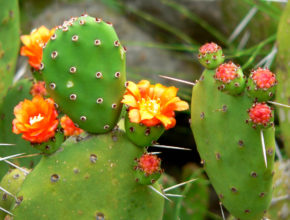
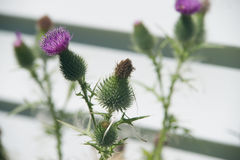
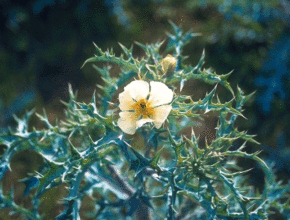
Prickly Pear Milk Thistle Prickly Poppy
Prickly Poppy Or Mexican Poppy. This is one of the most angry looking plants with a pretty white poppy on the top. OK imagine a NASTY thistle about 3 foot tall with 1 pretty flower. Thats the Mexican poppy
The Pods are one of the useful parts of the plant. But be forewarned. They are SPINEY
The pods are football shaped and thats the way to tell it from the Milk Thistle. The plants are VERY similar . Thistle pods are round and not as dangerous looking as the poppy.
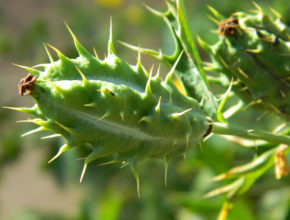
Prickly Poppy Pod
Gathering the Poppy
First a word of warning. The sap of the poppy has a mild narcotic type effect. It also has a caustic effect; It has been used successfully to burn off warts . This can result in a lot of painful scratches and possible infection and even chemical burns. Gloves ARE recommended.
The pods are gathered after flower has opened but before the pods split. Dry the pods in the sun, hanging to prevent mold until dry and brown. About 2 to 3 weeks. Next beat the living daylights out of the dry pods and sift the seeds out using a suitable screen. This is NOT fun work. A lot of desert plants make you work for their medicine.
The leaves are stripped from the plant and dried and then chopped fine.
The roots. The roots of the poppy will damn near cause a fist fight in a group of Southwestern herbalists. Some shun the roots like the coming of small pox, others powder or tincture them. The roots have the highest content of the needed alkaloids but care needs to be taken.
Using the Poppy.
The seeds. These look like another poppy seed. You can tincture them, and make a salve of them But DO NOT EAT THEM. They can and have killed people. Hell you can even smoke them. But don’t eat them. To make a salve use rendered lard, tallow or lanolin. Use a 1:2 ratio Seeds to oil. Do not use vegetable oils or beeswax. The properties of the poppy will cause it to go rancid at an accelerated pace. Some books, including one of the authors I highly respect, Michael Moore does suggest light consumption of the seeds in tea. However I have seen people come in to the ER with Alkaloid poisoning form over consumption. This can be a dangerous plant. HOWEVER. The seeds once toasted loose most the alkaloid properties and then they are fine topping for muffins!
The Leaves. Chopped and dried leaves made into a mild tisane is a wonderful treatment of sunburn and other 1st degree and even 2nd degree burns. As a tea it has a mild sedative effect, is good for minor urinary pain. Mixed with Skullcap it is good on nerve pain. In fact I’ll do a write up on it since I have pods drying. Add Silk Tassel to the tea and it does well as a antispasmodic. NOTE over use of the tea in a short amount of time will result in a TJ Swan or MD20/20 style hangover with out the pre hangover fun. The roots I treat the same as the seeds, Tincture them. But I do it as a green or fresh tincture. This I use 190 proof grain alcohol. Using 100 proof will not work as well since for as strong as 100 proof alcohol is It is still 50% water. Tincture for 4-6 weeks strain and bottle in a light proof glass bottle.
Acitve ingredients of plant are Protopine, Berberine, Atarine (notice a pattern here?) and other closley related alkaloids
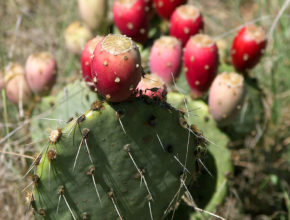
Prickly pear. This guy is in my front yard
Prickly Pear.
This little gem is one of the most populous plants . Its range is from California to Appalachian Mountains British Colombia to Argentina. But here in the desert is where we respect and use and yes curse the plant. The leaves (Or pads) the flowers and the pears are what you want. The roots have some uses but it is not worth the trouble to dig them out. You can even buy “skinned” Nopalitos The leaves in grocery stores here in the southwest. For some reason the prickly pear is endangered in Arizona. Come over to my yard I have PLENTY!
This plant, has multiple uses and it can even keep you alive. Take a bunch of the pads mash them up, dont worry about the spines. Putin a hole about a foot deep and 3 foot in diameter. Put your canteen cup ( You do have one right?) in the center of the hole cover it with plastic. Bury the edges of the plastic and leave it loose. Dont stretch it like a drum. Put a rock in the center, over the cup and come back in a couple of hours and you will have water.
The pads skinned and filleted are used the exact way as Aloe Vera, They are soothing to burns, cooling on shingles outbreaks. The skinned pads purreed in a blender is very soothing to UTI’s. It does nothing to the bacterial. But it creates a soothing of the inflamed tracts of the urethra and urinary tract.
The make a great drawing politices and are useful bruises. For burns they are as effective as Aloe Vera Soothing cooling and comforting. Another facet of the prickly pear is it may have a great use as a plant to combat Diabetes. This study in Mexico http://care.diabetesjournals.org/content/30/5/1264 shows a diet that prickly pear is part of lowered systemic glucose levels p to 30% compared to test diets with out them. Also they have been used for comfort during out breaks of Shingles
The dried flowers are very high in flavonoids. They are a good treatment for for mucosa that has been subjected to continual and intense inflammation. They work by strengthening the capillary beds. Traditional uses have been for chronic and mild asthma, colitis chronic vaginitis, any inflammations of the mucus membranes. It does not cure it nor reverse but it can help tissues to repair themselves. 1 flower in a well strained infusion 3 times a day. Did I say well strained? If you have ever had those hairs imbeded in your skin you will understand, If not PLEASE strain well. You do not want those barbed hairs in your system.
The Milk Thistle.
There are wide spread programs to eradicate this pest. And yes I support getting it off the cattle and sheep ranges.
The thistle for all its problems in the livestock and perfect lawn industry is really a very useful plant. It contains the flavonoid silymarin which for centuries has been shown to be very useful in helping the liver in heavy alcohol uses recover. That being said that is not the only reason to harvest this plant. In harvesting this plant and I wont say this about many, but dig the whole thing it up. Dig as many as you can. You will not put a dent in the population of it.
The thistle combined with plants like Echinacea and or Yerba Mansa it is good for overt infections.
Harvesting the thistles As early dig the whole thing out. As many as you would like. Remove the flower heads from the pods. There is no easy way. Well it is easier and safer than the prickly poppy, it isnt caustic and not as spiny. Pull the flowers off, a quick pin in the blender to break it up and set up a fan and trickle the mess slowly. It takes some practice to get the fluff to separate from the seeds. Once this is done . Dry for a week or so in flats and then store. At this point they can be ground and tinctured, stored whole and ground as needed for tea or capsules. Thistle for all its agricultural issue is really a useful plant. When it is controlled. Sort of. Almost.
Classes.
I have a bunch putting together. I have just about secured new classrooms. The Wilderness/Disaster Medic class is ready to make another round. For local students It will be done in 3-4 weekends in 7 modules. Hopefully this will get going by mid October.
Here is the module listing:
Module 1 Anatomy Physiology triage and trauma intro
Module 2 Shock and CPR 02 Administration
Module 3 Trauma Bleeding management
Module 4 burns thermal injuries Hematomas
Module 5 Wound Management and closures
Module 6 IV IV Certification
Module 7 Herbal Medicine
Herbal Medicine. October 1st As soon as I finalize the classrooms I’ll send out a special on it
http://themedicshack.net/basic-herbal-medicine/
Wound Care. October 22nd As above, As soon as I finalize the classrooms I’ll send out a special on it.
http://themedicshack.net/wound-care/
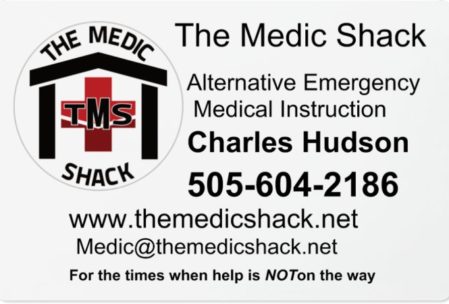
Items that will help with herb processing.
Sources
New Mexico State University Plant Net, Medicinal plants of the Desert Southwest By Michael Moore, The notes of Fedincia Martinez, my grandmother. Prepper’s Natural Medicine: Life-Saving Herbs, Essential Oils and Natural Remedies for When There is No Doctor By Cat Ellis
